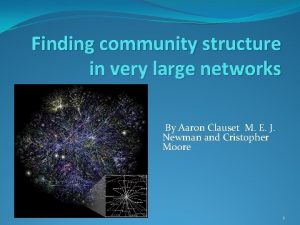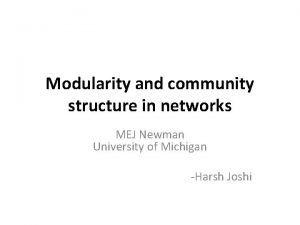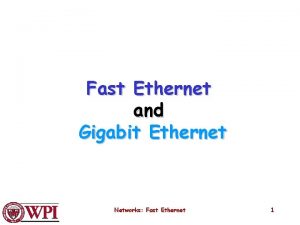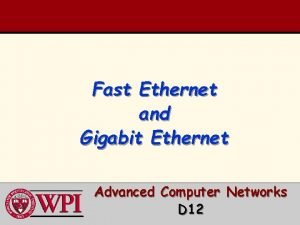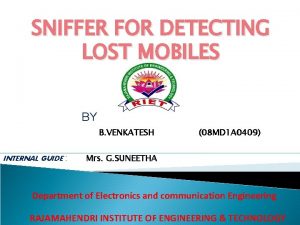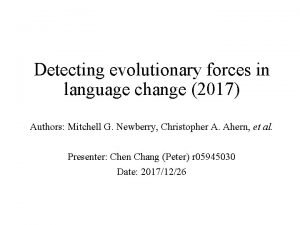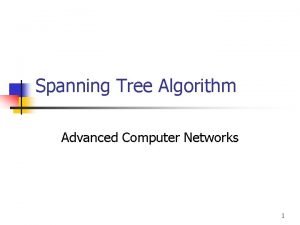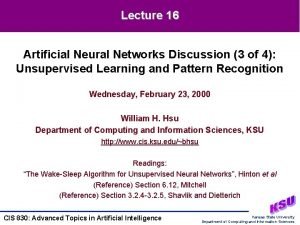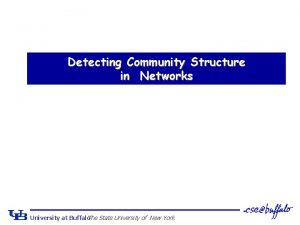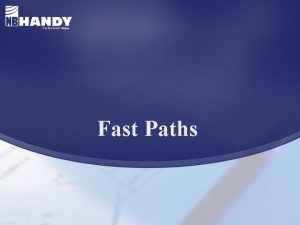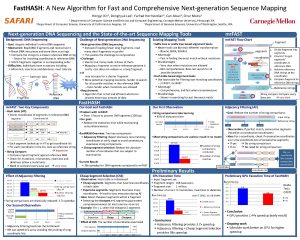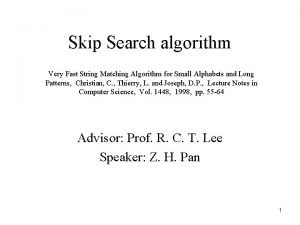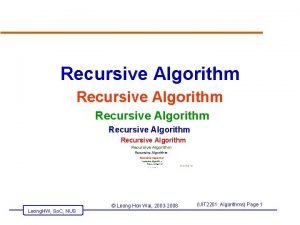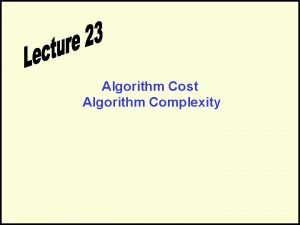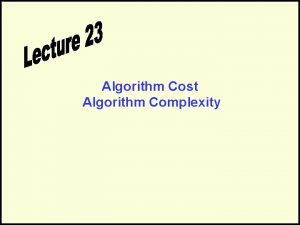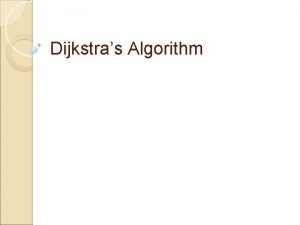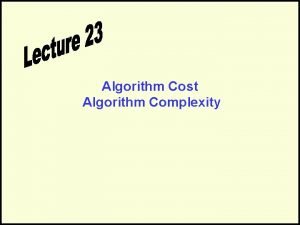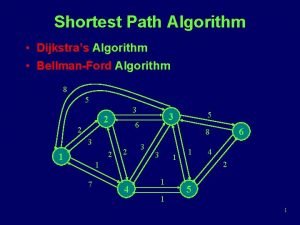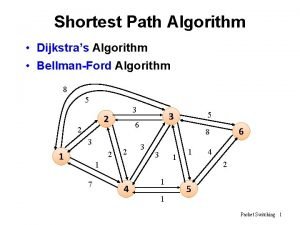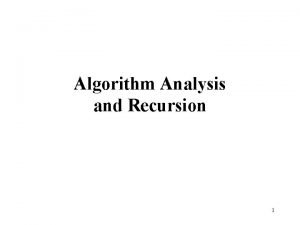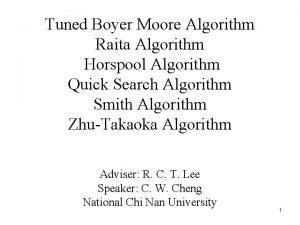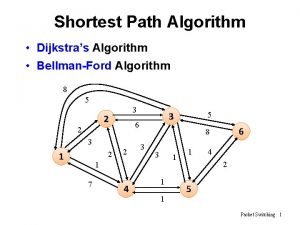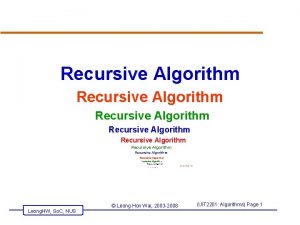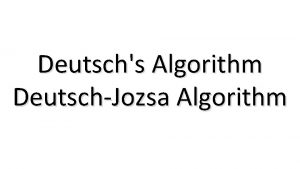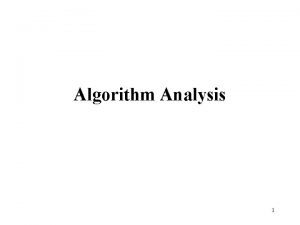Fast algorithm for detecting community structure in networks

























- Slides: 25

Fast algorithm for detecting community structure in networks. . (M. E. J. Newman, (2004 Presented by Muad Abu-Ata

Community structure • groups of vertices within which connections are dense but between which they are sparser. • Within-group( intra-group) edges. – High density • Between-group( inter-group) edges. – Low density.

Community Structure

Real Word Networks • • Internet World Wide Web. Citation Networks. Transportation Network. Email Networks. Food Webs. Social Networks. Biochemical Networks.

Examples of Community Structures • Communities of biochemical network correspond to functional units of some kind. • Communities of a web graph correspond to sets of web sites dealing with a related topics.

Finding Community Structures • Divide the network into non-empty groups( communities) in such a way that every vertex belongs to one of the communities. • Many possible divisions could be done. • We need a good division. • Measurement of good division.

Community Detection Approaches • Graph partitioning approaches: – Spectral bisection – The Kernighan-Lin (KL) algorithm • Hierarchical clustering. • The algorithm of Girvan and Newman. • The Newman fast algorithm.

Spectral bisection • • Eigen-vectors of the graph Laplacian. L = D-A A is the adjacency matrix D is a diagonal Matrix of vertex degrees 1 2 3 4 5 is always eigenvector with eigenvalue 0.

Bisect ! 1 2 3 4 5 The eigenvector corresponding to the lowest eigenvalue must have both positive and negative elements. +ve: reasonably fast; O(n 3) sparse matrix case, Lancozos method reduces it to approximately to

(. Spectral Bisection (Cont • Disadvantages: • It only bisects graphs into 2 communities. Division into a larger number of communities is usually achieved by repeated bisection, but this does not always give satisfactory results. • we do not in general know ahead of time how many communities we want to divide the graph into.

The Kernighan-Lin( KL) algorithm • 1. 2. 3. 4. Benefit function Q: the number of edges that lie within the two groups minus the number that lie between them. user specify the size of the two groups A & B. divide the vertices into the two groups randomly. Calculate the ∆Q for all possible exchange pair from A and B. Swap the pair that maximizes the change of Q. (greedy algorithm) 5. Repeat 3 & 4 until all vertices have been swapped once. (any vertex that has been swapped is never swapped. ) 6. Go back over the sequence of swaps and find the highest Q.

(. KL algorithm (cont Time complexity: O(n 2). -ve: requires a priori what the size of the groups will be. Running the algorithm for all possible group sizes O(n 3). The best values of Q are always achieved for very asymmetric trivial division.

Hierarchical clustering • develop a similarity (or dissimilarity) measure xij between pairs (i, j) of vertices. • Apply the hierarchical clustering and build the dendogram or tree. • Cross section the dendogram at any level will give the communities at that level.

Hierarchical clustering

Hierarchical clustering • Time complexity: O(n 2 logn) • N 2 vertex pairs. • Calculations of all similarity measures take O (mn). • Sorting N 2 similarity measures takes O(n 2 logn) for sorting. • Constructing the dendogram takes linear time. • it doesn't require us to specify the size or number of groups we want to look for beforehand. • -ve: – It does not tell us how many groups should be used to get the best division of the network (Where to cut!).

Girvan and Newman( GN) Algorithm 1. Edge Betweeness: The number of shortest paths between vertex pairs that goes along an edge. A B 2. 3. 4. Calculate the betweenness for all edges in the network. Remove the edge with the highest betweenness. Recalculate betweennesses for all edges affected by the removal. Repeat from step 2 until no edges remain. 5. 6. • cross cut the dendogram of components. By removing these edges, we separate groups from one another as components.

The GN Algorithm

The GN Algorithm • Time complexity: – O(m 2 n) O(n 3) • O( mn) for calculating edge betweeness. • m iterations. • -ve: – It provides no guide to how many communities a network should be split into (where to cross cut!). modularity measure.

Newman Fast Algorithm • Modularity Measure • the fraction of within-community edges minus the expected value of the same quantity for randomized network( edges fall at random with no regard to community structure) • Q= 0 no community structure. • 0. 3<Q<0. 7 significant community structure. • Generally the number of ways to divide n vertices into g nonempty groups is given by the Sterling number of the second kind S(n, g). The number of distinct community divisions is • Greedy approach to maximize Q.

Newman Fast Algorithm 1. 2. 3. 4. 5. Separate each vertex solely into n community. Calculate ∆Q for all possible community pairs. Merge the pair of the largest increase in Q. Repeat 2 & 3 until all communities merged in one community. Cross cut the dendogram where Q is maximum Notes: ∆Q=eij+ eji – 2 aiaj Calculate ∆Q only for pairs that are connected by an edge.

Newman Fast Algorithm

Newman Fast Algorithm

Newman Fast Algorithm • Time Complexity – O((m+n)n) O(n 2) for sparse graphs

Conclusion • Newman fast algorithm is: – considerably fast O(n 2) – gives good divisions. – No need a prior knowledge of the community sizes. – No need a prior knowledge of the number of communities.

References • Fast algorithm for detecting community structure in networks, M. E. J. Newman. • Detecting community structure in network, M. E. J. Newman. • Finding community structure in very large networks, Aaron Clauset, M. E. J. Newman, and Cristopher Moore.
 Finding community structure in very large networks
Finding community structure in very large networks Community detection in networks
Community detection in networks Non acid fast bacteria
Non acid fast bacteria Example of acid-fast bacteria
Example of acid-fast bacteria Fast ethernet network
Fast ethernet network Fast ethernet in computer networks
Fast ethernet in computer networks Gigabit ethernet in computer networks
Gigabit ethernet in computer networks Gigabit ethernet in computer networks
Gigabit ethernet in computer networks Virtual circuit and datagram networks
Virtual circuit and datagram networks Basestore iptv
Basestore iptv Sniffer for detecting lost mobiles
Sniffer for detecting lost mobiles Detecting evolutionary forces in language change
Detecting evolutionary forces in language change Detect golden ticket attack
Detect golden ticket attack How do fraud symptoms help in detecting fraud
How do fraud symptoms help in detecting fraud Havex
Havex Spanning tree algorithm in computer networks
Spanning tree algorithm in computer networks The wake-sleep algorithm for unsupervised neural networks
The wake-sleep algorithm for unsupervised neural networks Iso 22301 utbildning
Iso 22301 utbildning Novell typiska drag
Novell typiska drag Nationell inriktning för artificiell intelligens
Nationell inriktning för artificiell intelligens Returpilarna
Returpilarna Varför kallas perioden 1918-1939 för mellankrigstiden
Varför kallas perioden 1918-1939 för mellankrigstiden En lathund för arbete med kontinuitetshantering
En lathund för arbete med kontinuitetshantering Personalliggare bygg undantag
Personalliggare bygg undantag Tidbok yrkesförare
Tidbok yrkesförare A gastrica
A gastrica
